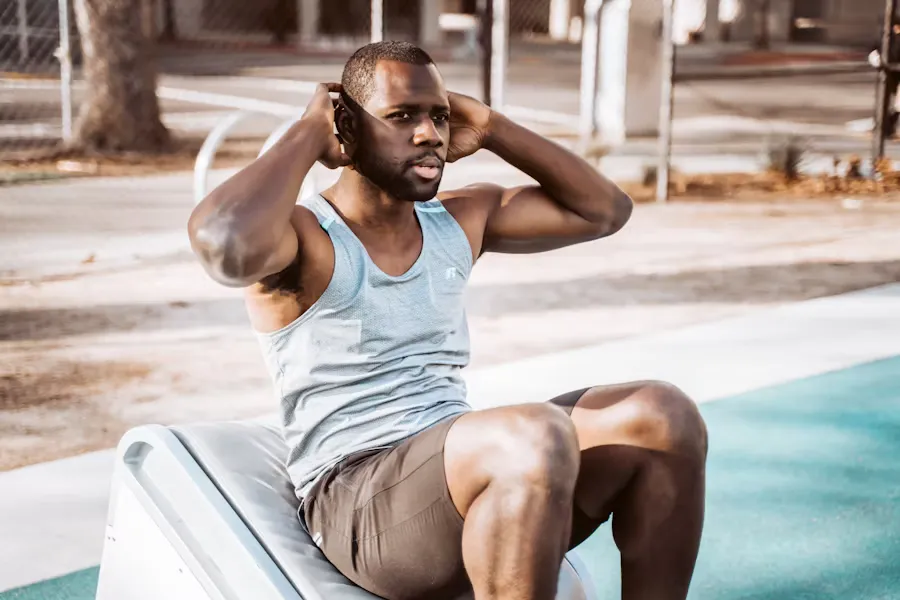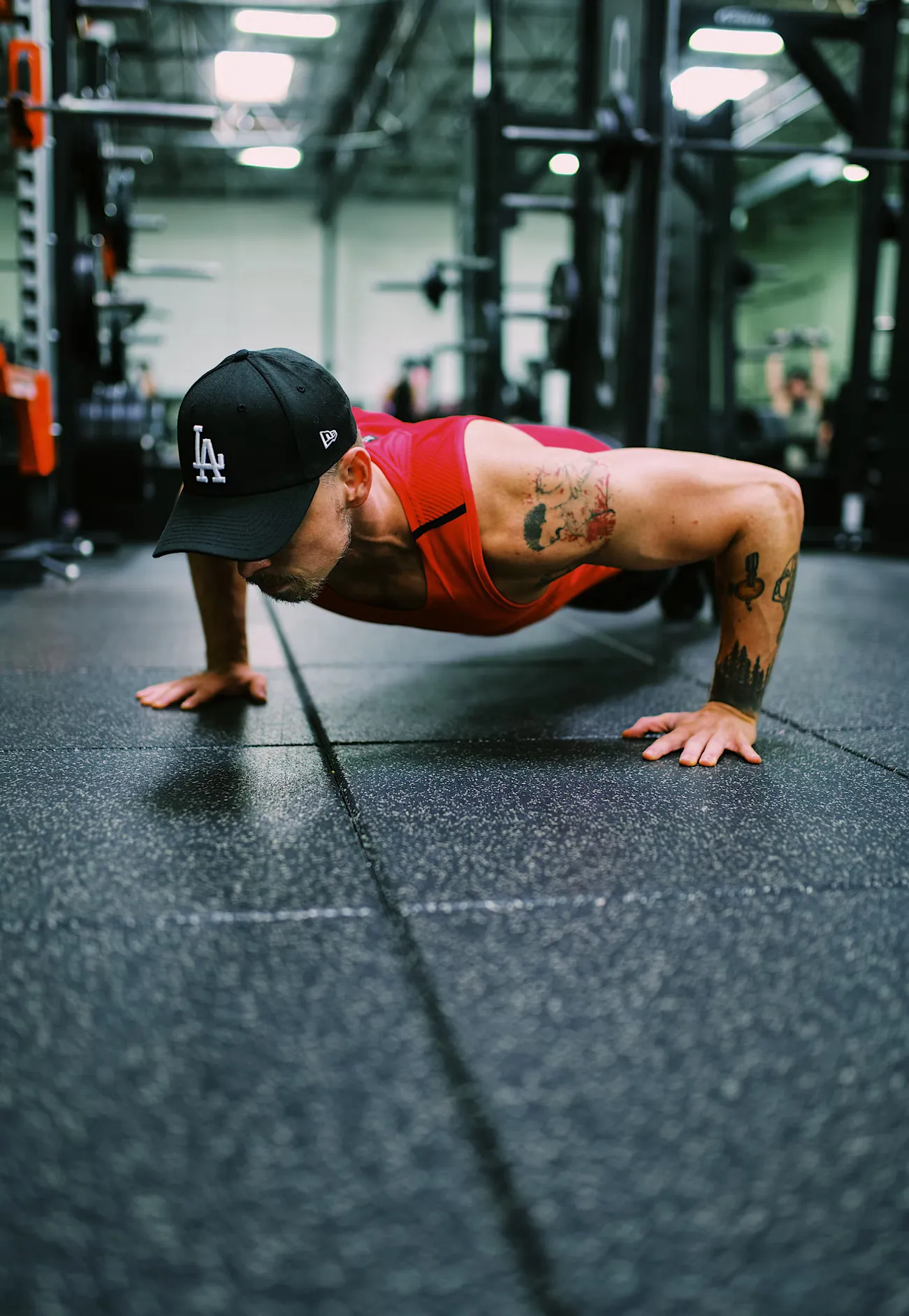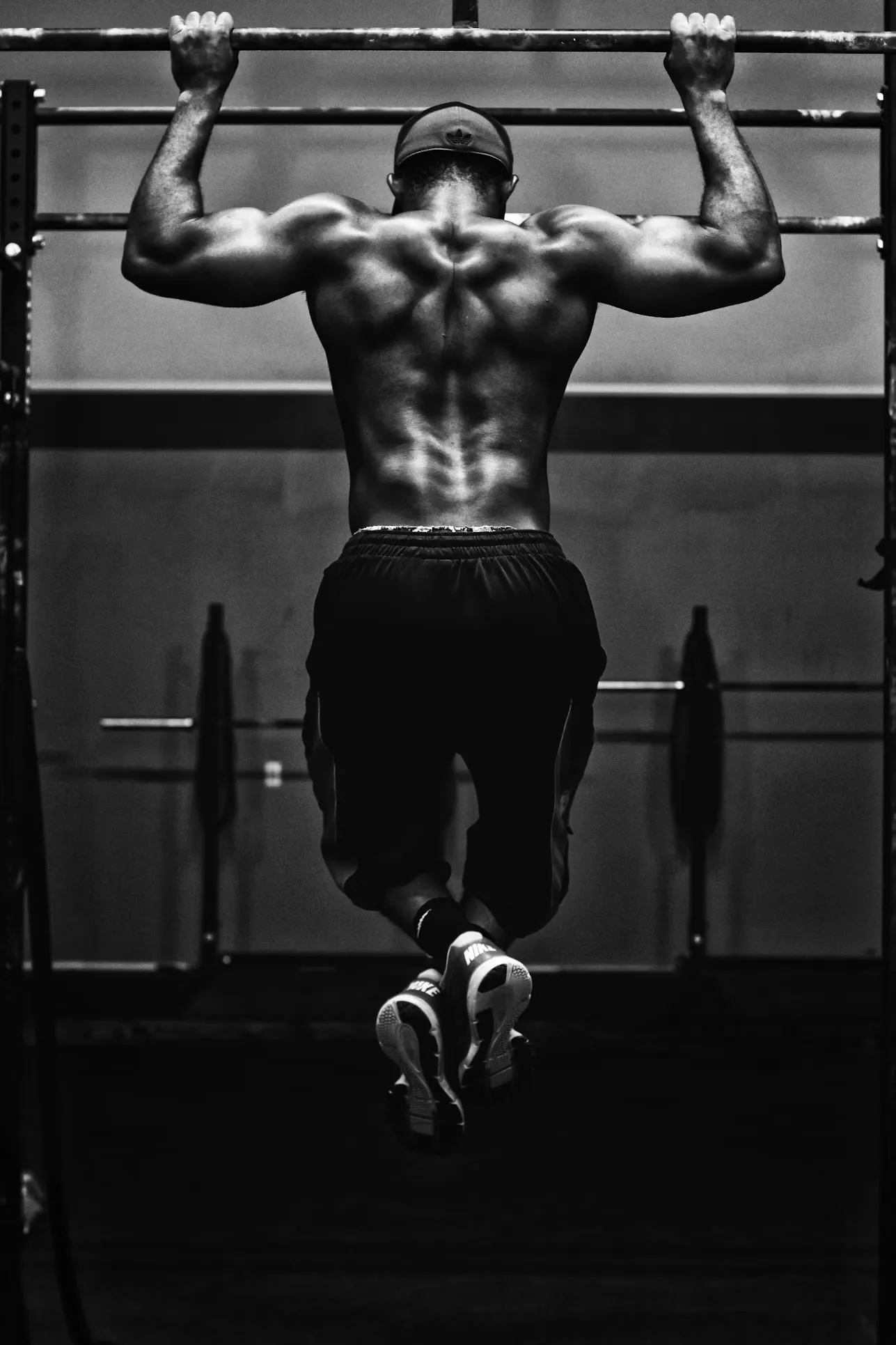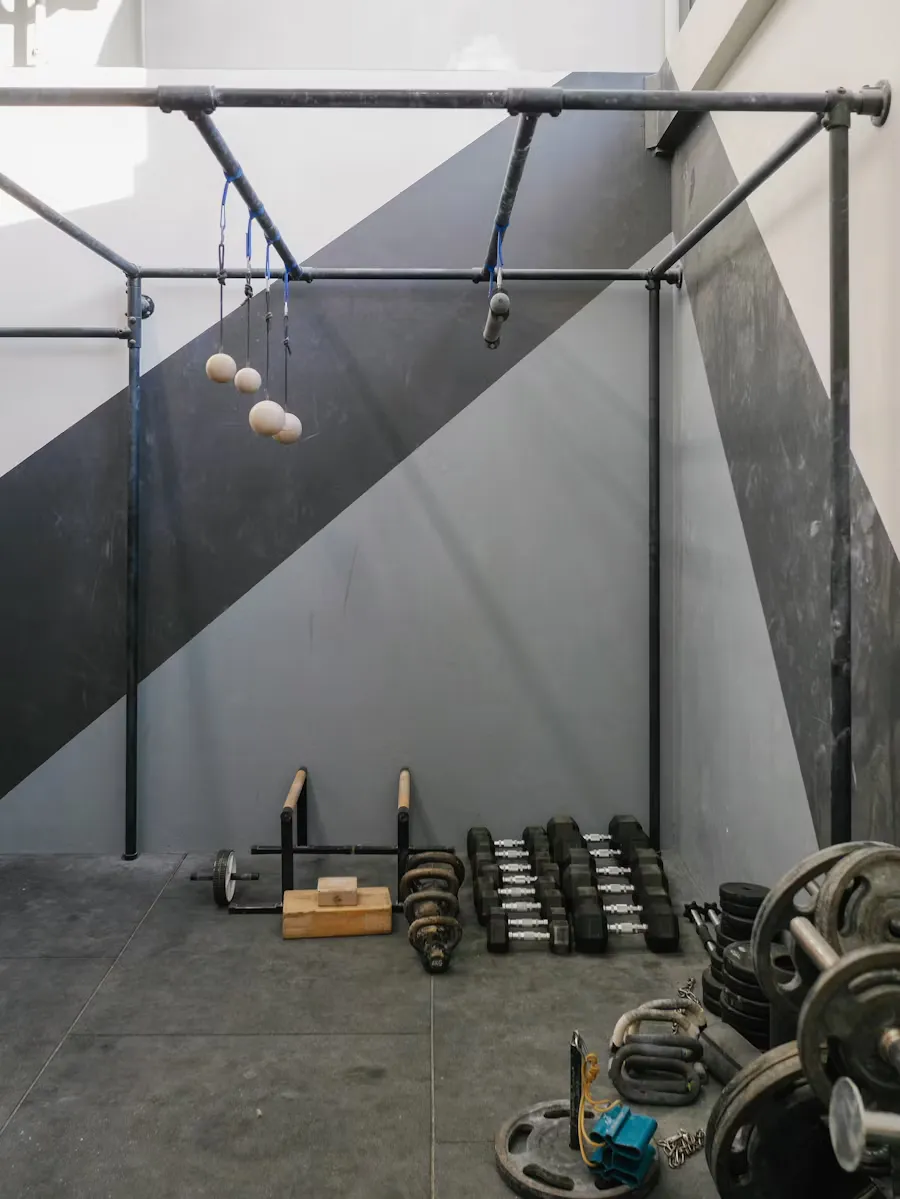· 24 min read
The Ultimate Guide to Calisthenics: Mastering Bodyweight Training for Strength and Mobility
Explore the comprehensive guide to calisthenics, from beginner to advanced exercises. Learn how bodyweight training builds strength, mobility, and endurance, with essential tips, progressions, and workout templates.

Table of Contents
- Introduction to Calisthenics
- Calisthenics Benefits and Scientific Evidence
- Beginner Calisthenics Workout Plan
- Essential Calisthenics Exercises
- Calisthenics Workout Plan for Maximum Results
- Calisthenics Equipment You Need (and What You Don’t)
- Calisthenics vs Weights and Hybrid Training Methods
- Calisthenics Diet and Nutrition Strategies
- Calisthenics Recovery and Injury Prevention
- Advanced Calisthenics Skills and Progressions
- FAQ: Your Calisthenics Questions Answered
Introduction to Calisthenics
Calisthenics has ancient roots dating back to Greek physical culture, where it was used to prepare warriors for battle. The term itself derives from the Greek words “kallos” (beauty) and “sthenos” (strength), perfectly capturing the essence of this training method that develops both aesthetic physiques and functional strength.
Calisthenics bodyweight training offers a comprehensive approach to fitness that develops strength, flexibility, and body control simultaneously. Unlike machine-based gym workouts that isolate muscles, calisthenics engages your entire body as a unit, building practical strength that transfers to real-world activities.
In its simplest form, calisthenics uses your body weight as resistance. This fundamental principle makes it accessible to anyone, anywhere, with little to no equipment required. From basic movements like push-ups and squats to advanced skills like the human flag or planche, calisthenics offers a lifetime progression path that can challenge even elite athletes.
The beauty of calisthenics lies in its scalability. Whether you’re a complete beginner who struggles with a single push-up or an advanced practitioner working on one-arm pull-ups, the principles remain the same: master the fundamentals, focus on proper form, and progressively increase difficulty.
As we move through 2025, calisthenics continues to grow in popularity, fueled by social media, accessible online training resources, and a shift toward functional fitness. This guide will take you through everything you need to know to start and advance your calisthenics journey, regardless of your current fitness level.
Calisthenics Benefits and Scientific Evidence

The calisthenics benefits extend beyond physical strength to include improved body awareness and movement control. But don’t just take my word for it—let’s look at what science tells us about this ancient training method.
Strength and Muscle Development
Research published in the Journal of Strength and Conditioning Research demonstrates that bodyweight exercises can be as effective as traditional weight training for building strength when properly progressed. One study comparing push-up progressions to bench press found similar muscle activation patterns when the exercises were matched for equivalent resistance.
What makes calisthenics unique is its focus on relative strength—your strength in relation to your body weight. This type of strength has greater carryover to everyday activities and sports performance than absolute strength alone.
Improved Body Composition
A 2018 study following participants through a 24-week calisthenics program found significant improvements in body composition, with an average decrease of 5.6% body fat and an increase in lean muscle mass. These changes occurred even without strict dietary controls, highlighting the effectiveness of progressive calisthenics for body recomposition.
Cardiovascular Health
When structured as circuit training, calisthenics workouts can significantly improve cardiovascular health. Research shows that high-intensity calisthenics circuits can elevate heart rate to 80-95% of maximum, providing cardiovascular benefits comparable to traditional cardio while simultaneously building strength.
Joint Health and Injury Prevention
Unlike heavy weight training, properly performed calisthenics places less compressive force on joints while still strengthening the supporting muscles and connective tissues. A 2020 review in the International Journal of Sports Physical Therapy noted that bodyweight training programs showed lower injury rates than free weight programs when participants were properly instructed in technique.
Mental Health Benefits
The mind-body connection in calisthenics extends to psychological benefits as well. Mastering new skills provides a sense of achievement that goes beyond the typical gym experience. Studies show that exercise focusing on skill development triggers greater dopamine release than repetitive exercise, potentially improving adherence and enjoyment.
Functional Movement Improvements
Perhaps most importantly, calisthenics improves how you move in everyday life. A 12-week study of adults performing bodyweight training showed significant improvements in functional movement screening scores, indicating better movement patterns and reduced injury risk during daily activities.
The evidence is clear: calisthenics isn’t just an alternative to weight training—it’s a comprehensive approach to physical development with unique benefits that extend far beyond the gym.
Beginner Calisthenics Workout Plan

Your first beginner calisthenics workout should focus on mastering fundamental movement patterns rather than advanced skills. This section will guide you through starting your calisthenics journey the right way, avoiding common pitfalls that lead to frustration or injury.
Calisthenics for Beginners: Common Mistakes to Avoid
Before diving into specific exercises, let’s address some common beginner mistakes:
Skipping progressions: Many beginners try advanced movements before mastering the basics, leading to poor form and potential injury.
Neglecting pulling exercises: Push-ups are accessible, but many beginners lack equipment for pulling exercises, creating muscle imbalances.
Inconsistent training: Sporadic workouts won’t build the neurological patterns needed for skill development.
Poor recovery: Beginners often train the same movements daily, not allowing for proper muscle recovery.
Ignoring form: Rushing through repetitions with poor technique limits progress and increases injury risk.
Bodyweight Fitness: The Foundation of Calisthenics Training
The foundation of any successful calisthenics practice lies in mastering these six basic movement patterns:
Horizontal Push (e.g., push-ups)
Horizontal Pull (e.g., rows)
Vertical Push (e.g., pike push-ups)
Vertical Pull (e.g., pull-ups)
Squat (e.g., bodyweight squats)
Hinge (e.g., glute bridges)
Your initial focus should be developing competency in all six patterns, even if some require modified versions to begin with.
Your First Workout Plan
Here’s a simple full-body routine perfect for beginners. Perform this workout 3 times per week with at least one rest day between sessions:
Incline Push-ups: 3 sets of 8-12 reps
Easier than standard push-ups; perform with hands on an elevated surface like a counter or benchBodyweight Squats: 3 sets of 15-20 reps
Focus on depth and keeping your heels downDoorway Rows or Bedsheet Rows: 3 sets of 8-12 reps
Use a sturdy doorway or a bedsheet over a closed door for these pulling exercisesGlute Bridges: 3 sets of 15-20 reps
Press through your heels and fully extend your hips at the topPike Push-ups: 3 sets of 8-12 reps
Place your hands on the floor and walk your feet forward until your body forms an inverted VPlank: 3 sets, hold for 20-30 seconds
Keep your body in a straight line from head to heels
Rest 60-90 seconds between sets. As these exercises become easier, increase repetitions or progress to more challenging variations rather than simply adding more sets.
Home Calisthenics Routine: Training Effectively Without a Gym
One of the greatest advantages of calisthenics is the ability to train effectively at home. Here’s how to set up your space:
Clear a space approximately 6’x8’ for movement
Identify a sturdy object for rows (like a table)
Find a wall space for wall sits and handstand progressions
Consider doorway options for pull-up progressions
Even with these minimal requirements, you can perform a complete beginner routine that builds the foundation for more advanced skills.
Remember, consistency trumps intensity when starting out. Focus on performing these exercises with perfect form rather than rushing to advanced movements. Your body needs time to build the proprioceptive awareness and tendon strength that will support your future calisthenics journey.
Essential Calisthenics Exercises

The most effective calisthenics exercises engage multiple muscle groups simultaneously for functional strength development. This section covers the fundamental movements that form the backbone of any successful calisthenics practice.
Push Exercises
Standard Push-up
The push-up is the quintessential calisthenics exercise for good reason. It engages the chest, shoulders, triceps, and core simultaneously.
Form keys: Hands slightly wider than shoulders, body in a straight line, elbows at about 45° from your body
Common error: Sagging hips or elevated shoulders
Progression path: Incline push-up → standard push-up → decline push-up → diamond push-up → archer push-up → one-arm push-up progression
Dips
Dips target the triceps, chest, and front deltoids with greater range of motion than push-ups.
Form keys: Shoulders down away from ears, slight forward lean for chest emphasis
Common error: Shrugging shoulders during the movement
Progression path: Bench dips → parallel bar dips → ring dips → weighted dips → Russian dips
Pull Exercises
Pull-ups
The gold standard for upper body pulling strength, pull-ups develop the latissimus dorsi, biceps, and grip.
Form keys: Start from a dead hang, pull until chin over bar, control the descent
Common error: Using momentum or not completing full range of motion
Progression path: Negative pull-ups → band-assisted pull-ups → full pull-ups → weighted pull-ups → one-arm pull-up progression
Rows
Horizontal pulling movements that balance push-ups and develop the middle back and rear deltoids.
Form keys: Body straight, pull elbows back alongside body, squeeze shoulder blades
Common error: Sagging hips or insufficient range of motion
Progression path: Incline rows → horizontal rows → decline rows → archer rows → one-arm row
Leg Exercises
Bodyweight Squat
The fundamental lower body movement pattern that builds quad, hamstring, and glute strength.
Form keys: Feet shoulder-width apart, depth below parallel, knees tracking over toes
Common error: Heels rising off the ground or knees caving inward
Progression path: Assisted squat → full squat → jump squat → pistol squat progression
Lunges
Unilateral leg exercises that address strength imbalances and build stability.
Form keys: Vertical torso, back knee nearly touching ground, front knee tracking over foot
Common error: Leaning forward or insufficient depth
Progression path: Static lunges → walking lunges → jump lunges → elevated lunges
Core Exercises
Plank
Isometric core exercise that builds endurance and stability throughout the entire midsection.
Form keys: Straight line from head to heels, engaged glutes, neutral spine
Common error: Sagging hips or elevated hips
Progression path: Forearm plank → full plank → single-arm plank → plank with leg lift → ring plank
Hanging Leg Raises
Dynamic core exercise that targets the lower abdominals and hip flexors.
Form keys: Start from dead hang, raise legs without swinging, control the descent
Common error: Using momentum or insufficient hip flexion
Progression path: Knee raises → straight leg raises → toes-to-bar → windshield wipers
Calisthenics Progression: How to Advance Through Different Skill Levels
The key to long-term success in calisthenics is understanding how to progress each exercise appropriately. Follow these principles:
Master the current level: Before advancing, you should be able to perform 3 sets of 8-12 clean repetitions of the current exercise variation.
Progress one variable at a time: Change either leverage, range of motion, or stability—not all three simultaneously.
Use intermediate steps: If the next progression feels too difficult, create intermediate steps by using partial ranges of motion or assistance.
Maintain quality: Never sacrifice form for progression. One perfect repetition teaches your body more than ten sloppy ones.
Be patient: Some progressions may take weeks or months to achieve. This is normal and part of the process.
By focusing on these fundamental exercises and their progressions, you’ll build the necessary strength foundation for more advanced calisthenics skills while developing balanced, functional strength throughout your entire body.
Calisthenics Workout Plan for Maximum Results

A well-designed calisthenics workout plan should include push, pull, and leg exercises for balanced development. This section will help you structure your training for consistent progress regardless of your experience level.
Calisthenics Training Program: Weekly Schedule for Consistent Progress
The ideal training frequency depends on your recovery capacity and goals, but most practitioners find success with one of these templates:
3-Day Full Body Split (Beginner-Friendly)
Monday: Full Body Workout A
Wednesday: Full Body Workout B
Friday: Full Body Workout A
Weekend: Rest/Active Recovery
4-Day Upper/Lower Split (Intermediate)
Monday: Upper Body
Tuesday: Lower Body
Thursday: Upper Body
Friday: Lower Body
Wednesday/Weekend: Rest/Active Recovery
5-Day Push/Pull/Legs Split (Advanced)
Monday: Push
Tuesday: Pull
Wednesday: Legs
Thursday: Push
Friday: Pull
Weekend: Rest/Active Recovery
6-Day Skill-Based Split (Advanced)
Monday: Straight Arm Strength
Tuesday: Bent Arm Strength
Wednesday: Legs/Core
Thursday: Straight Arm Strength
Friday: Bent Arm Strength
Saturday: Legs/Core
Sunday: Complete Rest
Programming Variables
Effective calisthenics programming manipulates these key variables:
Volume: The total amount of work performed (sets × reps)
Beginners: 6-10 sets per movement pattern per week
Intermediate: 10-16 sets per movement pattern per week
Advanced: 16-20+ sets per movement pattern per week
Intensity: The difficulty relative to your maximum capability
Strength focus: Higher intensity (harder progressions), lower reps (3-8)
Hypertrophy focus: Moderate intensity, moderate reps (8-15)
Endurance focus: Lower intensity, higher reps (15-30+)
Frequency: How often you train each movement pattern
Higher frequency (2-3× weekly per pattern) often works well for calisthenics
More advanced skills may require more frequent practice with lower volume
Rest Periods: Time between sets
Strength work: 2-3 minutes
Hypertrophy work: 60-90 seconds
Endurance work: 30-60 seconds
Sample Intermediate Full Body Routine
Here’s a sample routine for an intermediate practitioner training 3 days per week:
Workout A
Pull-ups: 4 sets of 5-8 reps
Pike Push-ups: 3 sets of 8-10 reps
Pistol Squat Progression: 3 sets of 6-8 per leg
Rows: 3 sets of 8-12 reps
Dips: 3 sets of 8-12 reps
Hanging Leg Raises: 3 sets of 10-15 reps
Workout B
Chin-ups: 4 sets of 6-10 reps
Pseudo Planche Push-ups: 3 sets of 8-10 reps
Shrimp Squat Progression: 3 sets of 6-8 per leg
Archer Rows: 3 sets of 6-8 per side
Ring Push-ups: 3 sets of 8-12 reps
L-sit Progression: 3 sets of max hold
Functional Calisthenics Training: Real-World Applications of Your Skills
The ultimate goal of calisthenics isn’t just to perform impressive tricks—it’s to build functional strength that transfers to daily life and athletic pursuits. Consider these applications:
Movement quality: Calisthenics improves posture, joint stability, and movement efficiency
Injury resilience: Tendon strength and body control reduce injury risk in sports and daily activities
Physical autonomy: The ability to control your body through space is empowering beyond the gym
When designing your program, periodically assess how your training is improving your quality of life outside of workouts. This connection between training and daily function is what makes calisthenics such a sustainable, lifelong practice.
Remember that consistency trumps perfection. The best program is one you can follow consistently, so adjust these templates to fit your schedule, recovery capacity, and preferences.
Calisthenics Equipment You Need (and What You Don’t)

Basic calisthenics equipment like a pull-up bar and parallel bars opens up a wide range of exercise possibilities. This section breaks down the essential gear, optional additions, and creative alternatives for every budget.
The Minimalist Approach
The beauty of calisthenics is that you can start with virtually no equipment. Here’s what you can accomplish with just your body and common household items:
Zero Equipment Exercises:
Push-ups (and variations)
Squats and lunges
Planks and core exercises
Glute bridges
Bear crawls
Household Substitutions:
Chairs for dips and elevated push-ups
Towel on smooth floor for hamstring curls
Sturdy table for rows
Stairs for incline/decline work
Backpack filled with books for added resistance
This minimalist approach is perfect for beginners, travelers, or those testing the waters before investing in equipment.
The Practical Home Setup
For those ready to invest a little and expand their training options, a simple home setup offers tremendous versatility while staying budget-friendly. With just a few key items, you can dramatically increase the range and intensity of your workouts.
Essential Gear:
Pull-up Bar: Wall-mounted or doorway models are perfect for pull-ups, chin-ups, leg raises, and hanging work.
Parallel Bars or Dip Station: Great for dips, L-sits, inverted rows, and building pushing strength.
Resistance Bands: Add resistance or assistance, depending on the movement. Useful for mobility and warm-ups too.
Gymnastic Rings: Extremely versatile and space-efficient — ideal for rows, dips, push-ups, and advanced core work.
Yoga Mat or Workout Mat: Provides cushioning for floor exercises and mobility work.
Optional Additions:
Adjustable Weight Vest: Adds scalable resistance to bodyweight exercises like push-ups, dips, and squats.
Ab Wheel: Excellent for core strength and anti-extension training.
Parallettes: Ideal for handstand practice, L-sits, and deep push-up variations.
Jump Rope: Simple, portable, and great for cardio.
Wall Space or Stall Bars: Useful for handstand training, flexibility work, and full-body mobility.
This approach balances cost and functionality, making it ideal for anyone building a home calisthenics practice. You get the benefits of equipment-based progression while keeping your space uncluttered and your setup manageable.
Calisthenics vs Weights and Hybrid Training Methods

Calisthenics doesn’t have to exist in isolation. In fact, combining it with other training methods — like weightlifting, cardio, or sport-specific conditioning — can lead to a more well-rounded and functional fitness foundation. Whether your goals involve building strength, enhancing endurance, or improving athletic performance, calisthenics can play a vital role.
How to Combine Calisthenics With Weight Training
Blending calisthenics with resistance training allows you to benefit from the best of both worlds — the control, stability, and mobility of bodyweight training, paired with the raw strength and hypertrophy stimulus of weights.
Tips for integration:
Alternate focus: Use calisthenics on push days and weights on pull days (or vice versa).
Use calisthenics as warm-up or accessory work (e.g., bodyweight dips after bench press).
Prioritize weights or calisthenics depending on your main goal (e.g., strength or skill development).
Example:
Pair barbell squats with pistol squat progressions or combine deadlifts with core-focused calisthenics like hanging leg raises.
Cardio and Calisthenics for Optimal Fitness
Calisthenics naturally supports cardiovascular endurance, especially when done in high-rep sets or circuits. When integrated intentionally, it becomes a powerful tool for conditioning and fat loss.
Effective combinations:
Circuit training: Push-ups, jump squats, burpees, and mountain climbers in timed intervals.
EMOM (Every Minute On the Minute): Rotate through bodyweight moves for metabolic conditioning.
Steady-state cardio (running, cycling, swimming) alongside calisthenics on alternate days for balanced recovery.
Sample Hybrid Workout Templates
Push/Pull Hybrid Split:
Day 1 – Pull Focus: Pull-ups, rows, bicep curls, band face pulls
Day 2 – Push Focus: Dips, push-ups, overhead press, ring supports
Day 3 – Legs/Core: Squats, lunges, glute bridges, L-sits, planks
Strength + Cardio Circuit:
10 pull-ups
20 push-ups
30 squats
400m run
Repeat 3–5 rounds
Periodization Approaches
To make consistent progress and avoid burnout, integrating calisthenics into a periodized plan is essential.
Block periodization: Alternate between strength, hypertrophy, skill, and endurance phases.
Concurrent training: Mix calisthenics and other modalities weekly, but rotate intensity (e.g., heavy strength + light skill work).
Skill-based periodization: Focus certain blocks on mastering movements like the muscle-up, planche, or handstand.
Recovery Management
Balancing different types of training increases recovery demands. Pay close attention to rest, mobility, and nutrition.
Key recovery strategies:
Prioritize sleep and hydration.
Schedule at least one full rest day per week.
Use active recovery (e.g., light calisthenics or walking) between intense sessions.
Incorporate mobility work daily — especially for shoulders, hips, and wrists.
Sport-Specific Calisthenics Applications
Calisthenics can be tailored to enhance athletic performance in sports by targeting movement patterns, coordination, and core control.
Examples:
Martial Arts: Explosive push-ups, planks, and isometric holds for striking power and body control.
Climbing: Pull-up variations, scapular work, and grip-specific holds.
Running: Single-leg squats, calf raises, and core training for better stride efficiency and injury prevention.
Team Sports: Agility drills, plyometrics, and coordination-based calisthenics improve functional athleticism.
Calisthenics Diet and Nutrition Strategies

Proper nutrition is a key pillar of performance, recovery, and long-term progress in calisthenics. Whether your goal is building strength, increasing endurance, or mastering advanced skills, fueling your body effectively is essential.
Caloric Needs for Different Goals
Your calorie intake should align with your training focus:
Muscle Growth (Bulking): Consume a slight calorie surplus (+250–500 kcal/day) to support muscle gain.
Fat Loss (Cutting): Aim for a modest calorie deficit (–250–500 kcal/day) to preserve muscle while reducing body fat.
Maintenance: Eat at your maintenance level for steady performance and body recomposition.
Use a TDEE (Total Daily Energy Expenditure) calculator as a baseline, and adjust based on training intensity and physical feedback.
Macronutrient Considerations
Balancing macronutrients ensures your body gets the fuel and recovery support it needs:
Protein: Crucial for muscle repair and growth. Aim for 1.6–2.2g per kg of bodyweight daily.
Sources: Eggs, chicken, tofu, Greek yogurt, legumes, fish, protein powders.Carbohydrates: Your main energy source, especially for high-rep calisthenics and endurance sessions.
Sources: Oats, rice, fruits, sweet potatoes, whole grains, beans.Fats: Support hormone health and recovery.
Sources: Nuts, seeds, olive oil, fatty fish, avocados.
Meal Timing Strategies
While total intake is most important, timing can support performance and recovery:
Pre-workout: A light meal or snack with carbs and some protein 60–90 minutes before training (e.g., banana + peanut butter or oats + protein).
Post-workout: Prioritize protein and carbs within 1–2 hours after training to replenish glycogen and support muscle recovery.
Even spacing: Distribute meals evenly throughout the day to maintain energy levels and promote protein synthesis.
Supplement Recommendations
Supplements aren’t required, but can help fill gaps in your nutrition:
Protein powder: Convenient way to hit daily protein goals.
Creatine monohydrate: Supports strength, power output, and muscle growth.
Omega-3s: For joint health and inflammation reduction.
Vitamin D & Magnesium: Often deficient, supports energy metabolism and recovery.
Electrolytes: Especially useful during long sessions or training in heat.
Hydration Guidelines
Hydration directly affects energy, endurance, and recovery:
Aim for 2.5–3.5 liters of water per day, more if you’re sweating heavily.
Include electrolytes during intense or long workouts.
Use thirst as a guide, but don’t wait until you’re dehydrated to drink.
General Meal Suggestions (Not a Strict Meal Plan)
Rather than following rigid plans, focus on consistent, whole-food nutrition. Include:
Proteins: Chicken, turkey, eggs, fish, Greek yogurt, tofu, tempeh, legumes
Carbs: Quinoa, brown rice, oats, whole grain bread, fruits, vegetables, beans
Fats: Avocados, nuts, seeds, olive oil, fatty fish
Snacks/Extras: Protein bars, smoothies, cottage cheese, trail mix, dark chocolate
Build meals around your training schedule, emphasizing quality ingredients and minimal processing. Listen to your body, track your energy, and adjust as needed.
Calisthenics Recovery and Injury Prevention

Recovery is just as vital as training when it comes to long-term calisthenics progress. A balanced approach that includes rest, mobility, and injury prevention ensures you can train consistently, avoid setbacks, and build a resilient body.
Common Calisthenics Injuries and Prevention
Bodyweight training is low-impact, but repetitive stress and poor form can still lead to injury. The most common issues include:
Shoulder strain or impingement (often from poor push-up or dip mechanics)
Wrist pain (from handstands, planche work, or lack of mobility)
Elbow tendinitis (from overuse in pulling movements like pull-ups)
Lower back strain (from poor core control or posture)
Prevention Tips:
Prioritize proper form over reps or intensity.
Warm up thoroughly, especially for wrists, shoulders, and hips.
Don’t skip foundational strength — build up gradually.
Use progressive overload smartly — not excessively.
Mobility Work for Longevity
Mobility supports joint health, control, and overall performance — especially in advanced calisthenics movements that demand range and stability.
Focus Areas:
Shoulders: Dislocates with a band or stick, wall slides, scapular mobility
Wrists: Wrist circles, palm lifts, fingertip push-ups
Hips: 90/90 transitions, Cossack squats, hip flexor stretches
Thoracic Spine: Foam rolling, thoracic rotations, cat-cow stretch
Incorporate 10–15 minutes of targeted mobility daily or post-training for best results.
Rest and Active Recovery Strategies
Rest days are not laziness — they’re a core part of your training cycle. Active recovery keeps the body moving without adding stress.
Effective Recovery Approaches:
Active Recovery Days: Light mobility flows, walking, yoga, swimming
Contrast Showers or Cold Therapy: May help reduce inflammation
Massage or Foam Rolling: Loosens tight muscles and improves circulation
Deload Weeks: Reduce training intensity every 4–6 weeks
Sleep Optimization for Performance
Sleep is your body’s best recovery tool. It directly affects muscle repair, cognitive function, and hormone balance.
Tips to improve sleep quality:
Aim for 7–9 hours per night
Avoid screens 60 minutes before bed
Keep your bedroom cool, dark, and quiet
Maintain a consistent sleep-wake schedule
Magnesium or herbal teas (like chamomile) may support relaxation
Stretching Routines
Stretching improves flexibility, reduces stiffness, and enhances recovery. Use both dynamic and static stretching at appropriate times:
Dynamic stretching: Pre-workout warm-up (e.g., leg swings, arm circles)
Static stretching: Post-workout or before bed (e.g., hamstring stretches, child’s pose, couch stretch)
A simple post-workout routine:
Forward fold (hamstrings)
Wall chest opener (shoulders)
Couch stretch (hip flexors)
Wrist flexor/extensor stretch
Spinal twist
Hold each stretch for 20–60 seconds.
Overtraining Warning Signs
Pushing too hard without adequate recovery leads to fatigue, plateaus, and injury.
Watch for:
Persistent soreness or joint pain
Decreased performance or motivation
Trouble sleeping or increased irritability
Elevated resting heart rate
Loss of appetite or frequent illness
If you notice these signs, scale back volume or intensity, increase rest, and re-evaluate your training plan.
Advanced Calisthenics Skills and Progressions

Mastering advanced calisthenics is a long-term journey that combines strength, control, mobility, and mental focus. Skills like the muscle-up, front lever, planche, and handstand push-up are more than just impressive — they represent a deep level of body awareness and functional strength. This section breaks down how to approach, program, and refine high-level movements in your training.
Skill Progressions for Impressive Moves
Every advanced skill has a logical progression — skipping steps only leads to frustration or injury. Master each phase with control before moving on.
Popular Skills and Sample Progressions:
Muscle-Up:
Jumping muscle-ups → band-assisted → explosive pull-ups → full muscle-upFront Lever:
Tuck hold → advanced tuck → one-leg → straddle → full front leverPlanche:
Planche lean → tuck planche → advanced tuck → straddle planche → full plancheHandstand Push-Up:
Pike push-ups → wall-supported HSPU → freestanding eccentrics → full freestanding reps
Use video tutorials or coaching to refine form and avoid common compensation patterns.
Training Approaches for Advanced Elements
Skill work requires precision, patience, and structure. Unlike general strength training, advanced skills benefit from frequent, low-fatigue practice combined with specific strength work.
Key Approaches:
Grease the Groove: Practice a skill multiple times per day at low intensity to build neural pathways.
Skill-first Programming: Train technical elements early in the session when fresh.
Cluster Sets: For hard holds or high-effort moves, use short rests between low-rep sets (e.g., 3x5s front lever holds with 20s rest).
Isometric + Dynamic Mix: Combine static holds with movement to build joint control and strength across ranges.
Mental Aspects of Skill Acquisition
Advanced calisthenics demands more than physical ability — it requires mental discipline, frustration tolerance, and focused intention.
Mindset Tips:
Visualize the movement before each attempt.
Log progress and celebrate micro-wins (e.g., longer hold, cleaner form).
Stay patient — some skills can take months or even years to master.
Use positive self-talk and stay process-focused, not outcome-obsessed.
Programming for Skills vs Strength
Balancing skill acquisition and strength training takes planning — both use energy and recovery differently.
Programming Considerations:
Prioritize skill development early in the week/session when focus and energy are high.
Train max-effort strength movements separately to avoid nervous system overload.
Use supportive strength work (like rows, dips, core, scapular control) to build the foundation for skills.
Limit high-skill training to 3–4x/week to avoid CNS fatigue.
Video Analysis Techniques
Recording your training is one of the most powerful tools for refining technique.
How to Use Video for Progress:
Film from multiple angles (side, front)
Use slow motion to spot breakdowns in form
Compare with earlier videos to track small improvements
Use drawing tools/apps to analyze body angles (e.g., angle of shoulder during planche lean)
Share with a coach or community for external feedback
FAQ: Your Calisthenics Questions Answered
Is 20 minutes of calisthenics enough?
Yes — especially for beginners or those short on time. A focused 20-minute calisthenics session using supersets, circuits, or high-intensity intervals can build strength, improve mobility, and elevate your heart rate. Consistency matters more than session length.
What is the 80/20 rule in calisthenics?
The 80/20 rule suggests that 80% of your results come from 20% of your efforts — meaning the foundational movements (push-ups, pull-ups, squats, planks) will deliver most of your progress. Master the basics first, and only then layer on advanced skills.
Can you get ripped with just calisthenics?
Absolutely. With the right nutrition and progressive training, calisthenics can build lean muscle and reduce body fat. Movements like pull-ups, dips, and bodyweight squats create full-body tension that stimulates muscle growth and definition.
How long before seeing results?
Most people start noticing improvements in strength, endurance, and body composition within 4–8 weeks of consistent training and good nutrition. Visible muscle definition and skill progress may take longer — depending on your starting point and goals.
Can women benefit equally from calisthenics?
Yes — calisthenics is highly effective for women. It builds functional strength, improves mobility, and supports lean muscle development without requiring heavy weights. Movements can be scaled to any fitness level and adapted for all body types.
Is calisthenics better than weightlifting?
Neither is inherently better — it depends on your goals. Calisthenics emphasizes relative strength, control, and mobility, while weightlifting focuses on absolute strength and hypertrophy. A hybrid approach often delivers the best overall fitness results.
Conclusion and Next Steps
Calisthenics is more than a workout style — it’s a sustainable path to building strength, control, and athleticism using your own body. Whether you’re starting with push-ups and squats or progressing toward muscle-ups and planches, the tools for success are within your reach.
Summary of Key Points
Start simple: You can make progress with minimal or no equipment.
Progress with purpose: Structured skill development and smart programming are key.
Train holistically: Combine calisthenics with cardio, weights, and solid nutrition for optimal results.
Recovery matters: Sleep, mobility, and rest days are non-negotiable.
Stay consistent: Long-term progress beats short-term intensity.
How to Stay Motivated Long-Term
Set skill-based goals (e.g., first pull-up, handstand hold, or planche progression).
Track progress weekly — reps, sets, hold times, or video logs.
Join a community to share wins, ask questions, and stay inspired.
Rotate challenges (e.g., 30-day push-up streak, mobility focus week).
Celebrate milestones, no matter how small — every rep counts.
Community Resources
Connecting with others can supercharge your motivation and knowledge:
Reddit: r/bodyweightfitness — great for form checks, advice, and progress logs
YouTube Coaches: Like FitnessFAQs, Tom Merrick, or Thenx
Apps and Trackers: Caliverse, Madbarz, or Progression for logging and routines
Local Calisthenics Parks or Groups: Search your city for meetups or outdoor gyms
Ready to Train Smarter?
Use the Workout Generator — build a custom workout based on your level, goals, and available equipment.

